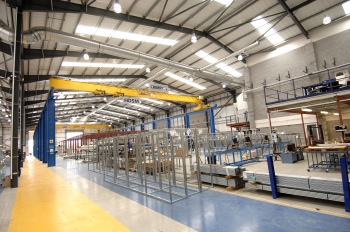Promoting a positive attitude to offsite manufacture

Despite its success in many major projects and its potential to bring major benefits to a project, offsite manufacture widely engenders caution. NG Bailey’s Graham Cleland shares his frustrations — and enthusiasm.
There is no shortage of examples where the proven benefits of offsite manufacturing have been harnessed to develop both bespoke and generic solutions to a range of construction demands.
We can all think of a project right now that, in the short time it takes you to read this article, is being enhanced by the extra dimensions this different approach can offer.
From our own experience, there are a number of major benefits, including the following.
• Overall build cost savings of up to 35%
• Improved safety by reducing the requirement for site labour by a typical 40%.
• Significant programme time savings
• better quality control and ‘through-life’ building performance
• Less waste and a lower carbon footprint to construct
 |
| Assembling building-services equipment in a controlled factory environment has many benefits over working on site. |
It is these advantages that have prompted clients and construction partners alike to break new ground and turn to offsite manufacture in record numbers over the past year.
Despite this being a healthy trend that is poised to gather momentum year-on-year, offsite manufacturing is itself facing a real-life challenge of its own — namely exploring ways of untying a Gordian Knot to accelerate this pace of growth.
It is difficult to quantify the exact contribution that offsite makes to the £90 billion that the construction sector is worth to the UK economy. Some researchers believe it could be as high as £4 billion, while others claim it is as low as £1.75 billion.
Wherever we sit on that range, those working in the increasingly specialised, technologically-advanced and skilled world of offsite are united in the view that it has the capability and capacity to play a far bigger role. The headroom to grow its market presence is clearly there, cementing its position as its own burgeoning community in the sector.
To do so, however, requires the offsite approach to be invited to play an earlier role in a project. One where we are at the very heart, and start, of the decision-making and design process for a project — devising innovation and developing new approaches.
All too often we are called upon in the later stages of planning and tasked with sub-optimally delivering one element of a specification where we have had little opportunity for involving our expertise and influencing the outcome of the overall construction.
 |
| Offsite manufacture of items such as plant rooms has a major effect on the requirement for labour on site. |
It’s something we experience across both the private and public sectors, where the word ‘offsite’ is conspicuous by its absence in all-too-many tender specifications and procurement processes — a trend that needs reversing.
Yet this is a task made all the more challenging by a sector that is traditionally conservative and risk adverse, and where a seachange in culture is required — embracing new ways of thinking and new ways of working, rather than maintaining the status quo of ‘that’s how we’ve always done it’.
Demystifying what offsite manufacture is all about — lifting tension and nervousness as a result — will be pivotal to exploiting the potential that lies before us. And gradually this is paving the way for change.
We still need more boldness from all stakeholders involved in a project and not to see offsite manufacture as risky but instead pivotal to unlocking a way to deliver better value to a client — in terms of cost certainty, programme certainty and assured quality.
Stakeholders who have already taken what Richard Branson would call an ‘adventurous decision’ have included clients for some of the most complex, challenging and largest projects we have ever been involved in, such as Heathrow Airport, Birmingham New Street Station, and the world’s largest dairy for Arla Foods.
Next time we all take a flight, board a train or put milk on the breakfast table, we need to remember the greater role that offsite manufacturing can play in bringing to life all our day-to-day activities in a quicker, safer, more sustainable and more cost-effective way.
Graham Cleland is general manager of NG Bailey’s offsite manufacturing division.







